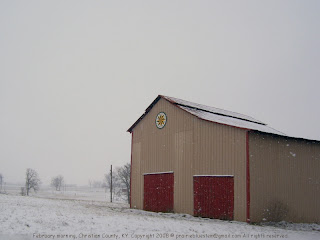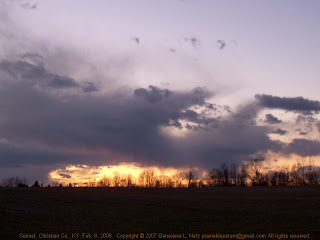Winter weather on the ranch
When the temperatures drop and we get some snow, my thoughts always go back to
bad snow storms on the ranch of my childhood.
We had a spell of cold, hard winters in Nebraska during the 1950s and 1960s. I mention those years because I remember them, but there were some bad winters during the 1940s, too, including the infamous
Blizzard of 1949.
I remember that night temperatures often dropped to 20° below zero (or even colder) during cold spells. During the day, it might warm up to zero. I remember one instance of night temperatures close to 40° below. Extremely cold temperatures made things that should have worked turn sluggish and break easily. The diesel fuel in the tractors always wanted to turn to jelly.
Feeding the Cattle
The cattle had to be fed every day, despite cold temperatures, wind, or snow. In a
blizzard, my dad, the hired man, my brother, and my mom, too, often worked the whole day just to get the cattle fed.
Before winter began,
the haystacks were moved to a stack-yard in the corner of each meadow that was closest to the ranch buildings. The nearest haystacks were saved for the very worst days.
To get a haystack for feeding, the "underslung", a wide trailer with a tilting bed, was pulled to the stackyard and parked beside a haystack. Then, the haystack (usually five tons or so in weight) was winched onto the underslung. All of this was made far more difficult by snow and extreme cold.
Then the loaded underslung was pulled with the tractor to the area where the cattle would be fed. We pastured the cattle close to the ranch buildings during the winter to make it easier to feed them. We had nice shelterbelts, and the cattle gathered close to them during bad weather. They always knew when a storm was coming.
Being unable to feed the cattle would have been such a horrible thing I can't imagine it. However, about ten years ago, the South Dakota blizzards were so terrible that ranchers couldn't feed their cattle despite tremendous, heartbreaking efforts. Some people lost most of their herds.
Blizzards and Lots of Snow
We judged the severity of a blizzard by how far we could see. If we could see the road that led from our mailbox to our house, we had half-a-mile visibility and it wasn't terrible yet. When we lost sight of that road and could only see the fence of the milkcow pasture -- or maybe not even that far -- the storm was very dangerous. Once we even heard loud claps of thunder during a raging blizzard.
My mother tried to keep a six-week stock of groceries during the winter. When she was able to go to town, she replenished her supplies thoroughly because she didn't know when she'd be able to shop again. Even when the county snow plows cleared the roads, they might quickly drift shut again if the weather turned bad.
When the roads were impassable, our mail delivery was suspended. The rural mail carrier brought the mailbags to
our rural store/post office where the mail was sorted. I suppose he delivered mail to the boxes along the highway, but he left the
mail for the boxes on gravel roads at the post office. If you needed mail service before the county snow plow came through, you had to plow your own way to the post office.
It's hard to imagine all that now from Kentucky, where we have only a few inches of snow every winter.
(UPDATED to add links and headings and polish up the text a little. I think I'm done with it now.)








 The photograph is an old family portrait. Fred was excited about it because it includes his grandmother (the sweet-looking lady at right,) some of his uncles, and other family members. One of the other ladies in the photo is the great-grandmother of the man who posted the family tree.
The photograph is an old family portrait. Fred was excited about it because it includes his grandmother (the sweet-looking lady at right,) some of his uncles, and other family members. One of the other ladies in the photo is the great-grandmother of the man who posted the family tree. I don't feel well. I have a little fever, chills, chest congestion, a cough, a drippy nose, aches and pains. Dennis wants to go shopping for a new (different) pickup truck this afternoon, but he may have to go alone.
I don't feel well. I have a little fever, chills, chest congestion, a cough, a drippy nose, aches and pains. Dennis wants to go shopping for a new (different) pickup truck this afternoon, but he may have to go alone.
 1. My husband who has put up with me for 29 years, through thick and thin, and much more. It's been interesting. :)
1. My husband who has put up with me for 29 years, through thick and thin, and much more. It's been interesting. :)
 We dodged last night's ice, but not the "wintery mix" that came down this evening. When I got off work at 5:00 p.m. it was cold and rainy and my car was iced over. I scraped it off and went to Kroger to get some milk and trash bags.
We dodged last night's ice, but not the "wintery mix" that came down this evening. When I got off work at 5:00 p.m. it was cold and rainy and my car was iced over. I scraped it off and went to Kroger to get some milk and trash bags.




 When I was a child in the Sandhills of northern Nebraska, most country folks still had a milkcow or two. Country kids grew up drinking fresh, unpasteurized milk, and lots of it. Most of our families had plenty of extra milk to make dairy-based treats occasionally -- such as hot cocoa.
When I was a child in the Sandhills of northern Nebraska, most country folks still had a milkcow or two. Country kids grew up drinking fresh, unpasteurized milk, and lots of it. Most of our families had plenty of extra milk to make dairy-based treats occasionally -- such as hot cocoa.